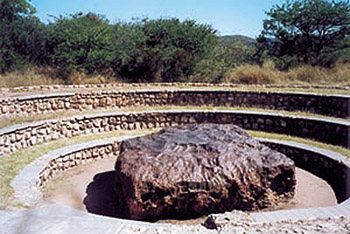 |
|||
|
|||
|
Copyright
The HBO Meteorite
The Hoba Meteorite consists of 82.4% iron, 16.4% nickel and 0.76% cobalt. Other elements present are traces of carbon, sulfur, and chromium, copper, zinc, gallium, germanium and iridium. Scientifically it is termed an ataxite, a meteorite with high nickel content. Under the microscope, material from the Hoba Meteorite displays the typical compact ataxitic structure with faint lines wedges and patches. The main minerals are kamacite (a nickel-iron alloy with 5-7% nickel) and taenite (a nickel-iron alloy with up to 65% nickel). High magnification shows intergrowth of the kamacite and taenite needles in the typical Wilmannstaetten structure. The meteorite also contains the more rare meteorite minerals schreibersite {(FeNi)3P}, toilite (FeS) and daubreelite {FeCr2S4}. The Hoba Meteorite is situated on the edge of the Kalahari plain that extends to the east and southeast. This plain is underlain by white calcrete of the Kalahari Group that fills the valley floors in the area. Underlying the calcrete are ancient granites as well as dolomites and limestones of the Otavi Group which also making up the surrounding hills. No crater or altered rocks have been found associated with the impact site. After the meteorite fell, a layer of calcrete gradually covered it. This calcrete was formed by the evaporation of near-surface groundwater, which carried calcium carbonate derived from the surrounding Otavi limestone. Today the region receives a maximum annual rainfall of only 175 mm and near the surface groundwater is less than abundant. The calcrete therefore suggests a more humid climate in the recent geological past. Unfortunately vandals have damaged the meteorite. In 1985, Roessing Uranium Ltd. made funds available to the National Monuments Council to combat vandalism. In collaboration with Roessing, the council launched a project to protect the meteorite and make the surroundings more attractive for visitors. Mr. J. Angelbrecht, the landowner since 1987, donated an area for the development of the site. Subsequently, an information center was established to meet educational needs. The facilities were opened on 31 July 1987.
This article may not be copied, distributed or reprinted in any form without the author's permission. To contact the author, please use the e-mail address provided. If you are unable to contact the author, please contact the Canadian Rockhound. Authorized reprints must acknowledge the author and the Canadian Rockhound.
|
||

Copyright © 2000 Canadian Rockhound
Back Issues |
News & Events |
Junior Rockhound |
Resources
|
|||
